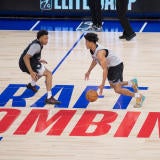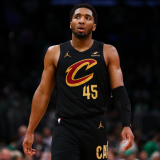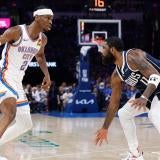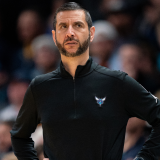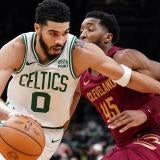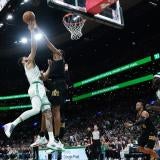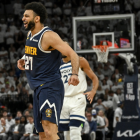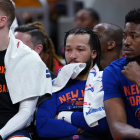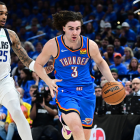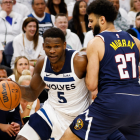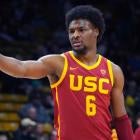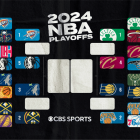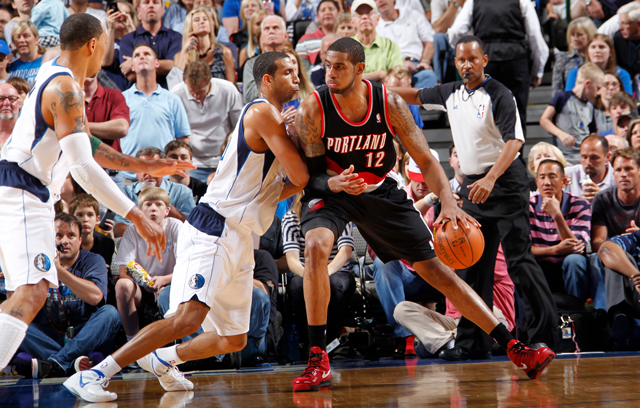 |
| LaMarcus Aldridge is the last man standing for the Portland Trail Blazers. (Getty Images) |
Over the next month, CBSSports.com's Eye On Basketball will take a team-by-team look at the 2012 NBA offseason. Next up: the Portland Trail Blazers. You can find our offseason reports here.
I. How they finished 2012:
Beep. Beep. Beep. Back that tank up. The Portland Trail Blazers blew up their 2011-12 season in March, firing coach Nate McMillan and trading away veterans Gerald Wallace and Marcus Camby after the team collectively decided to quit. The decision wasn't an easy one: after a few seasons spent delaying the inevitable and praying that Brandon Roy and Greg Oden would finally get healthy long enough for a real playoff push, the Blazers finally bit the bullet on a full-scale rebuilding effort. Wallace was traded for a first-round pick. Camby was moved for picks and expiring contracts. All-Star forward LaMarcus Aldridge was shut down for a minor hip surgery while other veterans like Raymond Felton and Jamal Crawford ceded some of their minutes to Portland's youngsters. Guys like J.J. Hickson, claimed off waivers, and Luke Babbitt, buried under McMillan, found their way into real minutes as the team predictably slid into the lottery with a 28-38 record.
Things were clearly changing, but that didn't necessarily mean there was a vision. Assistant coach Kaleb Canales was installed as the interim coach, the youngest head man in the entire league. The Blazers were operating with an acting GM, too: director of scouting Chad Buchanan had held the title the entire season after an on-again, off-again executive search failed to produce a hire. Meanwhile, owner Paul Allen, who had battled health issues in recent years, had said as recently as December 2011 that he wasn't sure he had the stomach for another rebuild. With a slashed payroll and uncertainties in the front office and on the bench, rumbles were beginning that perhaps this was a franchise being positioned for a sale.
II. Needs entering the offseason:
Other than a re-commitment from ownership, a new coach, a new GM and a few All-Stars to complement Aldridge, Portland didn't have much else to worry about this summer.
In all seriousness, the biggest needs were obvious. First, the team's ardent fan base needed a player, or group of players, to help turn the page from a team that badly disappointed and underachieved. Felton, in particular, was a pariah in the city after showing up out of shape and clashing with his coach. After years of leadership from Roy, among the most fan-friendly and media savvy players in the league, a disconnect between team and city sprung up quickly as the losses and bad attitudes mounted. Empty seats in the Rose Garden became the norm. What was missing: good reason for hope.
As important as hope was direction. President Larry Miller had made big promises regarding the team's plans for summer free agency. Portland had significant cap room although it also faced a decision on restricted free-agent forward Nicolas Batum, long seen as one of the team's future building blocks. Any splashy play in free agency would be coming on a tight timeline because Batum was sure to generate interest. Who would make the moves? The patchwork front office of Miller and Buchanan? Someone else? And who would hire the coach?
Positionally, the Blazers needed to address their backcourt, as both Felton and Crawford were as good as gone the minute the season ended. Point guard, in particular, was a glaring need, as Felton had been the theoretical "point guard of the future" when he was acquired in 2011, and back-up Nolan Smith hadn't shown much in his rookie season. The center position also remained a big question. Aldridge can slide over in small-ball lineups, but he prefers his power forward position. With Camby traded, Oden released and recovering from a third microfracture surgery, and veteran Joel Przybilla past his days as a No. 1 option, the Blazers had a huge hole to fill in the middle.
As the summer opened, Allen sent an open letter to fans expressing his disappointment with the previous season but also stated his continued desire to turn the Blazers into a championship contender. With that question answered, the Blazers could proceed with their draft and free agency plans.
III. The Draft:
The Blazers began addressing some of their needs before the 2012 draft, hiring GM Neil Olshey away from the Los Angeles Clippers. Olshey brought with him an upbeat attitude and a distinct feeling that he planned to put his own stamp on the upcoming era. Shortly thereafter, Miller, who reportedly opposed Olshey's hiring, tendered his resignation. In August, Olshey hired an outsider as his team's new head coach, Dallas Mavericks assistant Terry Stotts, rather than give the full-time head job to Canales. (For his troubles and his non-stop work ethic, Canales was kept on Stotts' staff as a "defensive coordinator" assistant.)
Olshey's first order of business, though, was the draft. With Aldridge in place at the four and plans to retain Batum as the starting small forward, the Blazers filled needs with their three picks. The big catch was point guard Damian Lillard, selected sixth overall using the pick acquired from the Nets in exchange for Wallace. An excellent athlete and late-bloomer, Lillard was named co-MVP of Las Vegas Summer League after showcasing his full offensive game. That includes the ability to shoot from range, get to the basket and finish above the rim. Possessing a quiet confidence, Lillard has already established himself as a fan favorite. His strong summer succeeded in turning the page from last year's debacle.
With the No. 11 pick, the Blazers selected Illinois center Meyers Leonard, a 7-footer with good agility who has the necessary length and quickness to be a shot-blocker. Leonard isn't a back-to-the-basket post player, but Aldridge's status as a No. 1 scoring option makes that an acceptable shortcoming. Portland's scouts have compared him to Tyson Chandler and Anderson Varejao, and he'll likely see as many minutes as he can handle this season. Foul trouble will surely result, but he should have some flashes, too.
With their second-round pick, the Blazers took lithe guard Will Barton out of Memphis, whom some expected to go in the first round. An excellent rebounder for his position, Barton can score in a variety of ways and plays with an obvious hunger. A highly-ranked player coming out of high school, his slip in the draft order can be explained by one obvious question: Will he be able to add enough bulk to his skinny frame? The Blazers were pleased with their ability to nab Barton with the No. 40 pick, and the decision to take him looked even better when reserve off guard Elliot Williams tore his Achilles during a workout last week, ending his 2012-13 season before it started. Barton now pencils in to get big minutes behind starter Wesley Matthews.
All in all, it was a logical, hole-plugging draft from a franchise that hasn't had much to show from its picks in recent years. Lillard will be thrown into the fire from Day One and will be given every opportunity to develop into a franchise player. Leonard's development will be monitored closely, but he'll have room and time to learn from his mistakes. Barton gets a legit shot to stick and real minutes, more than you can say for most second round picks.
IV. Free Agency:
Given the tight timeline created by the restricted free agency of Nicolas Batum, the Blazers had to act fast if they wanted to land any major players in free agency. They did so, offering a four-year maximum contract worth $58 million to Indiana Pacers center Roy Hibbert. The Pacers, coming off their best season in years and with some flexibility of their own, opted to match the offer sheet as expected and dashed Portland's hope of pairing two All-Stars in its frontcourt. The Hibbert offer sheet was more of a dream than a real plan, a fact that became clear as the Blazers quickly made it known they had no back-up targets. The big-name acquisition that Miller had promised the previous season was not to be. With that, the possibility of a trip to the 2013 playoffs became very unlikely.
As for the Batum saga, it dragged on and on, as the Minnesota Timberwolves and president David Kahn tried to push every available button to encourage the Blazers to enter sign-and-trade discussions for the French forward. Allen was fully committed to Batum, though, and eventually agreed to match Minnesota's four-year, $46.5 million offer sheet, paying Batum significantly more than comparable players like Danilo Gallinari and Ryan Anderson.
The rest of Portland's free agency moves were aimed at maintaining flexibility while adding young talent. The Blazers brought over two former first-round draft picks who had been stashed in Europe -- Joel Freeland and Victor Claver -- while re-signing Hickson to a modest one-year deal worth $4 million. Veteran point guard Ronnie Price was added on a minimum deal to serve as a back-up and mentor for Lillard.
To finish cutting ties from last season and to fill out the 15-man roster, the Blazers agreed to sign-and-trade Felton, along with aging big man Kurt Thomas, to the New York Knicks to stockpile some minor assets (picks and cash). They also acquired Jared Jeffries in that deal and helped facilitate the Houston Rockets' sign-and-trade of Courtney Lee to the Boston Celtics, adding Sasha Pavlovic and two future second-round picks in that one.
Meanwhile, Felton joined the Knicks, Crawford signed with the Clippers, Przybilla signed with the Milwaukee Bucks, Wallace re-signed with the Nets, Camby signed with the Knicks, reserve center Hasheem Thabeet signed with the Oklahoma City Thunder and reserve forward Craig Smith signed overseas. 2013 will indeed be a brand new year.
V. Overall grade and accomplishments: C
Where did this flurry of moves leave Portland? Pretty much where you would have expected. The problem children were all been shipped out, and the veterans who would have been wasting their time during a rebuilding season fled or were traded. The team's new core trio -- Aldridge, Batum and Matthews -- is in place together through at least 2014-15 with Lillard and Leonard on track to fill out the starting lineup of the future. The bench is young and lacking in talent but also cheap and liquid. Considering all of those components, the Blazers are well positioned for a tossaway season that results in plenty of development time for everyone who needs it plus another solid lottery pick to add to the core.
This was a painful-but-necessary summer for the Blazers. Portland took on some calculated risks, drafted fairly well, overpaid Batum because it was unable to sign him to an early extension and added no other meaningful impact players because the previous management regime made a series of moves that limited its options. In the short term, the Blazers' hopes depend almost entirely on the growth arc of Lillard, who seems to have star potential but is, obviously, an unproven commodity. Should he develop along a best-case scenario, becoming an elite point guard relatively soon, this summer will wind up as an "A" in hindsight. If not, this could get long and ugly.
The good news is that Olshey wiped the slate mostly clean this summer. But his franchise enters a dangerous phase with an obvious deadline and the clock ticking. Portland has only two seasons to put together a winning team and convince Aldridge that he should stick around before the All-Star enters the final year of his current contract. As we've seen in recent years, a small-market All-Star's final year is a dangerous place for a franchise to be if it lacks a solid core group and immediate playoff success possibilties around him. The leverage balance can become untenable and destructive.
But that's still a matter of crossing that bridge when the time comes. Until then, everyone just sits back and (hopefully) enjoys the Lillard show.






